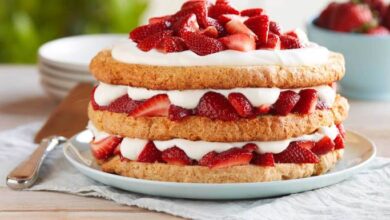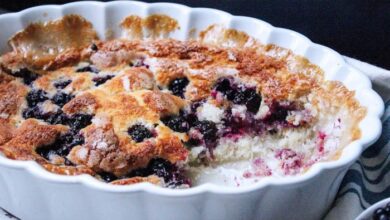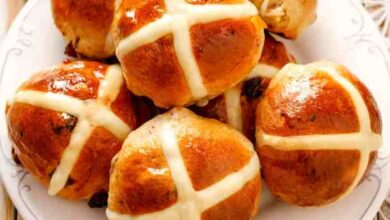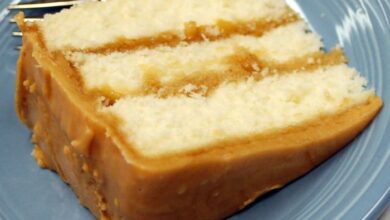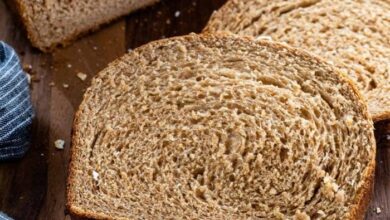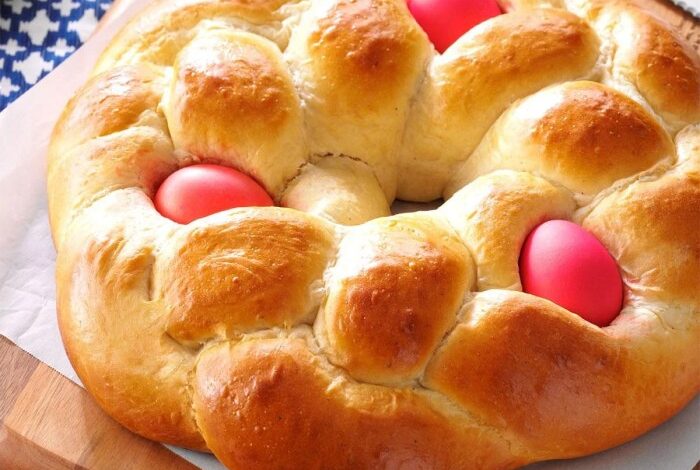
Sweet Braided Easter Bread: A Delicious Tradition
Sweet braided Easter bread, a delightful and symbolic treat, has been a cherished tradition for centuries. This beautifully woven loaf, often adorned with colorful sprinkles and delicate flowers, is a centerpiece of Easter celebrations worldwide. From its origins in ancient Europe to its modern variations, the braided Easter bread holds a special place in culinary history and cultural heritage.
The bread’s intricate braid symbolizes the intertwining of faith, family, and community, making it a perfect representation of the joy and renewal associated with the Easter season. The sweet flavors and textures of this bread, often infused with fruit, nuts, or spices, are a testament to the artistry and creativity of bakers throughout the ages.
Join me as we explore the fascinating world of sweet braided Easter bread, from its historical roots to its modern-day interpretations.
History and Origins
The history of braided Easter bread, also known as “Easter braid,” is a testament to the rich cultural tapestry of Europe and beyond. This sweet bread, often adorned with colorful eggs and sprinkled with sugar, holds deep roots in various traditions and has evolved over centuries to become a cherished symbol of Easter celebrations.
Cultural Traditions and Variations
Braided Easter bread is a testament to the diversity of culinary traditions around the world. Its origins can be traced back to various cultures, each contributing its unique flavor and symbolism to this beloved bread.
- Central and Eastern Europe:In these regions, braided Easter bread, known as “Paska” or “Babka,” is a staple of the Easter feast. It often features a sweet dough enriched with butter, eggs, and spices, and is frequently decorated with intricate designs and symbols.
The braid itself represents the intertwined threads of life and the unity of family.
- Scandinavia:In Scandinavia, a similar bread known as “Påskbröd” is traditionally enjoyed during Easter. This braided bread is typically made with a sourdough starter and often incorporates cardamom for a distinctive flavor. It’s often served with butter and jam, and its braided shape symbolizes the interwoven strands of the Easter story.
- Italy:In Italy, a braided Easter bread called “Colomba Pasquale” is a popular treat. This bread is characterized by its distinctive dove shape, which represents peace and the Holy Spirit. It’s often flavored with citrus zest and candied fruits, and its delicate sweetness makes it a delightful Easter dessert.
Symbolism of the Braid
The braid itself holds significant symbolism in Easter celebrations. It represents the intertwining of the three strands of the TrinityFather, Son, and Holy Spirit. The braid also symbolizes the interwoven threads of life, family, and faith, reminding us of the interconnectedness of all things.
“The braided shape of Easter bread is a visual representation of the interconnectedness of life, family, and faith.”
Sweet braided Easter bread is a tradition in our family, and the aroma of the yeast dough baking in the oven is a sure sign that spring is here. After enjoying a slice of this delicious bread, I love to cool off with a scoop of homemade cherry ice cream – the recipe I use is a family secret, passed down through generations.
The sweet and tart flavors of the cherry ice cream complement the richness of the Easter bread perfectly, making it a truly satisfying dessert.
Ingredients and Techniques: Sweet Braided Easter Bread
The delightful aroma and soft texture of braided Easter bread, often called “challah” or “sweet bread,” are the result of a careful combination of ingredients and meticulous techniques. The richness of the bread comes from the interplay of flour, yeast, eggs, and sugar, while the braiding adds a visual appeal that embodies the celebratory spirit of Easter.
Ingredients
The essential ingredients for braided Easter bread include:
- Flour:The foundation of the bread, flour provides structure and texture. Bread flour, with its higher protein content, creates a strong gluten network that allows for the dough to rise and hold its shape during braiding.
- Yeast:This single-celled organism is responsible for the bread’s rise. As the yeast consumes sugar, it produces carbon dioxide gas, which gets trapped within the gluten network, creating the airy and light texture of the bread.
- Eggs:Eggs contribute to the bread’s richness, moisture, and golden color. The yolks provide a deep yellow hue and a velvety texture, while the whites add volume and structure.
- Sugar:Sugar acts as food for the yeast, encouraging fermentation and contributing to the bread’s sweetness. It also helps to soften the dough and promote browning during baking.
- Milk or Water:These liquids hydrate the flour and create a workable dough. Milk adds a subtle sweetness and richness, while water provides a neutral base.
- Butter:Butter enhances the flavor and adds richness to the bread. It also helps to create a tender crumb and a golden-brown crust.
- Salt:A small amount of salt is essential for flavor and helps to balance the sweetness of the bread. It also strengthens the gluten network, contributing to the bread’s structure.
- Flavorings:To enhance the bread’s taste, additional flavorings such as vanilla extract, citrus zest, or spices like cinnamon and nutmeg are often added.
Braiding Techniques
The braiding of Easter bread is a time-honored tradition, adding a visual element of beauty and symbolism to the bread. The intricacy of the braids can vary, but the basic technique involves dividing the dough into strands and weaving them together.
- Preparing the Dough:The dough for braided Easter bread is typically made with a rich, yeasted dough that is allowed to rise until doubled in size. This allows the yeast to develop and create the airy texture.
- Dividing the Dough:The risen dough is then divided into equal portions, usually three or four, depending on the desired braid pattern.
- Rolling the Strands:Each portion of dough is then rolled into a long strand. The length of the strands will determine the length of the braided loaf.
- Braiding:The strands are then woven together in a variety of patterns. The most common braid is a three-strand braid, but more intricate patterns, such as a four-strand or even a five-strand braid, are also possible.
- Securing the Ends:Once the braid is complete, the ends are tucked under the loaf to secure the braid and prevent it from unraveling during baking.
Variations and Flavor Profiles
The beauty of braided Easter bread lies in its adaptability. It’s a blank canvas, ready to be adorned with an array of flavors, textures, and colors. This versatility allows for endless variations, catering to individual preferences and regional traditions.
Fruit-Filled Delights
Fruit-filled braided Easter breads are a classic and beloved variation. The sweetness of the fruit complements the rich, buttery flavor of the bread, creating a delightful harmony.
- Raisins:These plump, dried grapes are a staple in many braided Easter bread recipes. They add a sweet, fruity note and a chewy texture.
- Currants:Smaller and more tart than raisins, currants provide a distinct flavor and a slightly tangy contrast.
- Candied Citrus Peel:The bright, citrusy flavors of candied orange or lemon peel add a refreshing twist to the bread. The chewy texture also adds an interesting contrast.
- Dried Apricots:These dried fruits offer a unique sweetness and a soft, chewy texture. They add a distinct, apricot flavor to the bread.
- Dates:Their rich, caramel-like sweetness and chewy texture make dates a delightful addition to braided Easter bread.
Nutty and Savory Variations
For those seeking a more savory or nutty flavor profile, there are numerous variations that incorporate nuts and spices.
Sweet braided Easter bread is a delightful tradition, but sometimes you crave something a little different. For those moments, I turn to the comforting warmth of pumpkin oatmeal chocolate chip cookies. They’re a perfect balance of spice and sweetness, reminding me of cozy autumn evenings.
But after a few bites, I always find myself yearning for the delicate sweetness and intricate braids of that Easter bread again!
- Walnuts:These nutty additions provide a rich, earthy flavor and a satisfying crunch.
- Pecans:With their buttery flavor and delicate crunch, pecans enhance the richness of the bread.
- Almonds:Their slightly bitter flavor and crunchy texture create a delightful contrast with the sweetness of the bread.
- Pistachios:These vibrant green nuts offer a unique, slightly sweet flavor and a satisfying crunch.
- Spices:Adding spices like cinnamon, nutmeg, or cardamom adds a warm, aromatic dimension to the bread.
Taste and Texture Comparisons
The choice of ingredients significantly impacts the taste and texture of braided Easter bread.
- Fruit-Filled:These variations are typically sweeter and more indulgent. The fruit adds a burst of flavor and a chewy texture.
- Nut-Studded:Nut-studded braided Easter breads offer a richer, more savory flavor profile. The nuts provide a satisfying crunch and a delightful textural contrast.
- Spiced:Spiced variations add warmth and depth to the flavor of the bread. The spices create a complex and aromatic experience.
Serving and Presentation
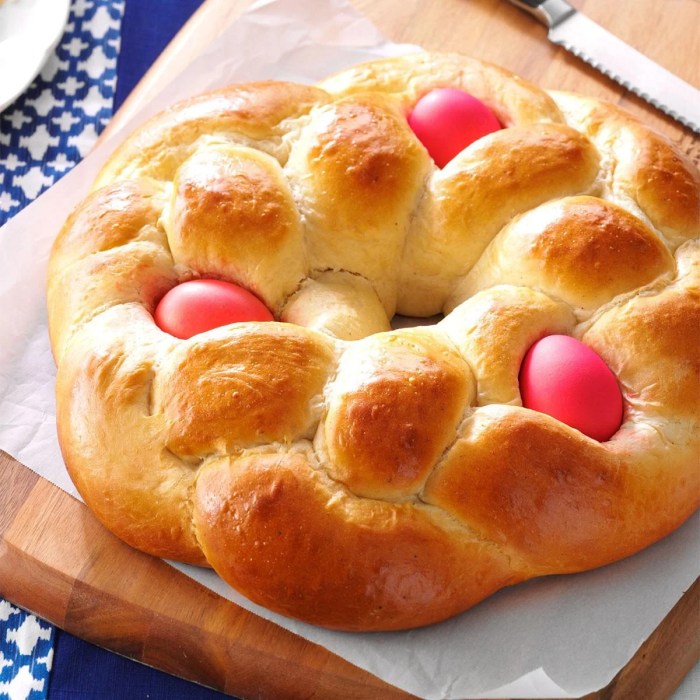
Braided Easter bread, with its rich flavors and beautiful appearance, deserves a presentation that reflects its celebratory nature. Serving this festive bread is an art, allowing you to showcase its beauty and enhance the overall dining experience.
Sweet braided Easter bread is a delightful tradition, and while the dough is rising, I like to whip up a refreshing side dish. This year, I’m planning on making a mango peach and pineapple salsa to complement the bread’s sweetness.
The vibrant flavors of the salsa will be a perfect counterpoint to the rich, buttery bread, creating a balanced and delicious Easter meal.
Creative Serving Ideas
A variety of serving options can elevate the presentation of braided Easter bread. Here are some ideas:
- Warm and Sliced:Serving the bread warm and sliced allows guests to savor the bread’s fresh aroma and soft texture. Arrange the slices on a beautiful platter or cutting board, accompanied by a selection of spreads like butter, honey, or jam.
- Individual Servings:For a more intimate setting, consider serving individual portions of braided Easter bread. These can be presented on small plates or in charming baskets, each adorned with a sprig of rosemary or a sprinkle of cinnamon.
- Table Centerpiece:The braided Easter bread itself can be a stunning centerpiece. Arrange it on a decorative platter or cake stand, surrounded by fresh flowers, candles, or other festive elements. This creates a visually appealing focal point for your Easter table.
Decorative Elements
Decorative elements can enhance the visual appeal of your braided Easter bread, adding a touch of elegance and festivity.
- Glaze:A simple glaze can elevate the presentation. A classic vanilla glaze adds a touch of sweetness and shine. For a more elaborate touch, you can experiment with flavored glazes like lemon, orange, or chocolate.
- Sprinkles:Sprinkles add a playful and colorful touch. Choose sprinkles in festive colors like pastel pink, yellow, and blue, or opt for colorful nonpareils for a more vibrant look.
- Edible Flowers:Edible flowers like pansies, violas, and rose petals add a touch of elegance and freshness. Arrange them delicately on top of the bread for a beautiful and fragrant presentation.
Visual Guide for Arranging Braided Easter Bread
A visually appealing presentation of braided Easter bread requires a few simple steps:
- Select a Serving Platter:Choose a platter or cake stand that complements the style of your table setting. A wooden platter with a rustic feel or a white ceramic plate with a classic look can both work well.
- Center the Bread:Place the braided Easter bread in the center of the platter. Make sure it is positioned straight and level.
- Add Decorative Elements:Arrange your chosen decorative elements around the bread. You can place a sprig of rosemary, a few edible flowers, or a sprinkle of sprinkles around the base of the bread.
- Finishing Touches:Add a final touch by placing a small bowl of butter, honey, or jam alongside the bread. This provides guests with options for enjoying the bread.
Cultural Significance and Traditions
Braided Easter bread, with its rich history and symbolic meaning, transcends the realm of mere culinary delight, becoming a cherished tradition interwoven with cultural heritage and religious beliefs across various regions. From the vibrant celebrations of Easter Sunday to the intimate family gatherings, this bread holds a special place in the hearts and homes of many.
The Symbolism of Braided Easter Bread
The intricate braid of Easter bread, often adorned with colorful eggs, carries a profound symbolism that resonates throughout the Christian world. The three strands of the braid represent the Holy Trinity: the Father, the Son, and the Holy Spirit. The sweet taste of the bread symbolizes the joy and renewal associated with the resurrection of Christ.
In some traditions, the braided shape is also seen as a representation of the crown of thorns worn by Jesus during his crucifixion.
Recipe and Baking s
This section will guide you through a classic braided Easter bread recipe, offering step-by-step s for achieving a delicious and visually appealing result. We’ll cover the ingredients, techniques, and baking process, ensuring you have everything you need to bake your own Easter bread masterpiece.
Ingredients and Preparation
The key to a successful braided Easter bread lies in the quality of the ingredients and proper preparation. Here’s a breakdown of what you’ll need:
- Yeast:Active dry yeast is the most common choice, but you can also use instant yeast. Ensure the yeast is fresh and active.
- Milk:Warm milk provides a moist environment for the yeast to activate and helps develop the bread’s texture.
- Sugar:Sugar feeds the yeast and contributes to the bread’s sweetness.
- Eggs:Eggs add richness, moisture, and structure to the dough.
- Butter:Melted butter enhances flavor and adds a tender texture.
- Salt:Salt balances the sweetness and enhances the overall flavor.
- Flour:All-purpose flour is the most commonly used, but you can experiment with bread flour for a slightly chewier texture.
- Raisins and Candied Fruit:These traditional additions provide sweetness and visual appeal. You can customize the amount and type of dried fruits according to your preferences.
Before you begin mixing the dough, make sure all your ingredients are at room temperature. This helps ensure the yeast activates properly and the dough comes together smoothly.
Mixing and Kneading the Dough
- Activate the Yeast:In a small bowl, combine warm milk, sugar, and yeast. Let it sit for 5-10 minutes, until the yeast is foamy. This indicates it is active and ready to work.
- Combine Wet Ingredients:In a large bowl, whisk together eggs, melted butter, and salt.
- Add Dry Ingredients:Gradually add flour to the wet ingredients, incorporating it with a wooden spoon or spatula until a shaggy dough forms.
- Knead the Dough:Turn the dough out onto a lightly floured surface and knead for 8-10 minutes, or until smooth and elastic. You can use a stand mixer with a dough hook for this step.
- First Rise:Place the dough in a greased bowl, cover it with plastic wrap, and let it rise in a warm place for about 1 hour, or until doubled in size.
Braiding the Dough
- Punch Down and Divide:After the first rise, punch down the dough to release air bubbles.
Divide the dough into three equal pieces.
- Shape the Strands:Roll each piece of dough into a long rope, about 18 inches long.
- Braid the Strands:Place the three ropes side-by-side. Braid them together, starting from one end and working your way down. You can use a classic three-strand braid or experiment with more intricate patterns.
- Place in a Pan:Gently place the braided dough into a greased loaf pan. Tuck the ends of the braid under the loaf to prevent them from unravelling during baking.
- Second Rise:Cover the loaf with plastic wrap and let it rise in a warm place for about 30-45 minutes, or until it has almost reached the top of the pan.
Baking and Finishing Touches, Sweet braided easter bread
- Preheat Oven:Preheat your oven to 350°F (175°C).
- Brush with Egg Wash:Before baking, brush the loaf with a mixture of egg yolk and a tablespoon of water. This will give the bread a beautiful golden-brown crust.
- Bake:Bake the bread for 30-40 minutes, or until it is golden brown and sounds hollow when tapped.
- Cool:Let the bread cool in the pan for 10 minutes before transferring it to a wire rack to cool completely.
Tips and Tricks for Success
- Use Warm Milk:Make sure the milk is warm, but not hot. Hot milk can kill the yeast.
- Don’t Overknead:Overkneading can make the bread tough.
Stop kneading when the dough is smooth and elastic.
- Proof in a Warm Place:A warm environment helps the yeast rise more quickly. You can use a warm oven (turned off) or a warm spot on your counter.
- Don’t Overbake:Overbaking will dry out the bread.
Test for doneness by tapping the bottom of the loaf. It should sound hollow.

